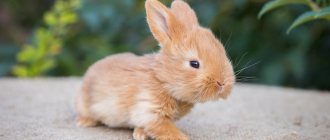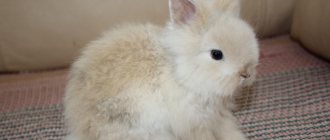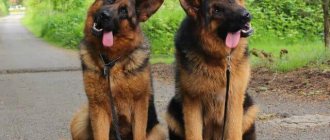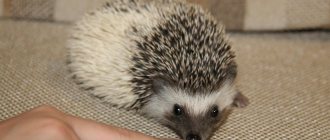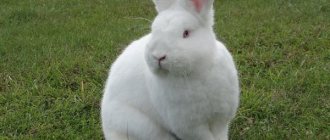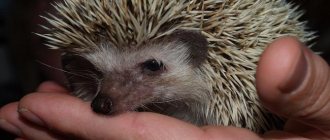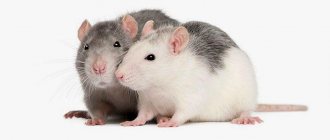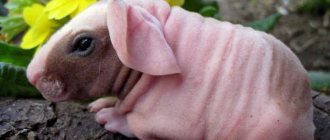Interesting facts about the Dwarf Ram breed
Many varieties of miniature bunnies go by the common name "dwarf rams." In the midst of frequently encountered and beloved ones, one can create:
- Mini Lop is a British dwarf ram. It differs in that it has a square head, the paws are very massive, and the ears are dense, but not long.
- NHD is a Dutch dwarf ram. Unlike other relatives, the head is round, the eyes are huge, and the ears are short.
- ZWW - refers to the German dwarf ram, a traditional breed.
Regardless of the breed of bunnies size is small and their weight is no more than one and a half kg. As for the ears, they are very long, up to 28 cm.
Dwarf rams have become widespread in the world; they are not only kept at home, but also taken to various exhibitions.
Mini lop
The breed was bred in Germany. These animals were obtained by crossing Dutch fold rams and dwarf chinchillas. The first mini-lops were white, but later other colors were obtained. The breed was officially recognized in 1980.
Characteristic:
- Weight: 1400-2700 g.
- Ear length: should be 2-3 cm below the jaw, drooping.
- Wool: medium.
- Color: any.
- Price: 8-17 t.r.
Mini lop has a strong body. The head is rounded and quite large. The neck is very short. The limbs are thick, not curved, and short. These rabbits are very good-natured, so even small children can communicate with them without any problems.
When did the breed appear?
The idea of creating a mini version of the French sheep breed bunnies came to Dutch breeders, and they were able to bring it to life in the 20th century. To develop the breed, ordinary decorative bunnies were crossed with the French ram breed, resulting in the NHD breed. The new breed quickly caught the taste of society, which is why it is not mind-blowing that it quickly spread throughout America and all of Europe.
The Mini Lop breed was bred in England, and the German ZWW bunnies are from Germany. Regardless of the breed of decorative bunnies, they are all very kind and soft, which is why they can easily replace shaggy cats. As for the disposition of animals, it will depend only on whether the owner raised him correctly.
The average life expectancy is up to 7 years, but with proper care and feeding it can be significantly longer.
Sizes of decorative rabbits and weight
Story
The forefathers of rams are feral bunnies of the Mediterranean and Western Europe. The origin of the decorative variety is usually attributed to the 19th century. The first ornamental rams became the reward of British breeders who decided to consolidate the gene acquired as a result of mutation.
Nowadays, sheep breed bunnies with a hump on the nose are widespread in many countries. They are especially popular in Europe.
The dwarf ram rabbit (Nederlande Hangoor Dwerg) is a decorative breed of bunnies that is very popular. In general, this fame is not at all difficult to explain, because they are truly charming and look like smaller copies of lambs. Their peculiarity is their ears, which are shaped like a horseshoe, since the auricles are turned inward. Ear length – 23-28 cm.
The body of bunnies has a cylindrical shape, the small neck smoothly runs into the beautiful line of the back, the back is round, the back of the head is small but powerful. The frontal paws of the animal are of medium thickness, not very long, the tail is small and fits tightly to the body. Females differ not only in size, but also in the fact that they do not have dewlaps. The ears are perfectly feathered, the head is powerful, with a wide forehead, for which, in fact, the breed received the nickname “lamb”.
The bunny's skin is soft, even, and has a thick undercoat. As for the dimensions, dwarf rams weigh from 1.2 to 2 kg; individuals that weigh more are not allowed to take part in exhibitions. By the way, it is necessary to take miniature individuals only from the most experienced breeders, since dishonest traders can often slip small two-month-old rabbits to naive buyers, passing them off as adults. Ram rabbits are quite fertile; they have up to 6 young rabbits in their litter.
Disadvantages are considered to be a poorly developed head or its incorrect shape, protruding or very drooping ears, and a narrow bone structure. There are several coat varieties: longhair, lionhead, shorthair and satin. For all colors, there are requirements for the quality of the undercoat, pattern, rosettes, and markings.
From the history of the dwarf ram species
In Russia, dwarf rams appeared not so long ago - only 10-15 years ago, but they have already gained popularity among lovers of decorative bunnies. This is a fairly young breed, which was the result of crossing miniature individuals with a French ram (meat breed). It was bred in 1950 in Holland, and in 1952 the breed was introduced to the public for the first time. Bunnies received final recognition in 1964.
The dwarf ram is widespread in the world, it is perfect for keeping in the family and will become a favorite of children. This is a beautiful pet for children over 10, and if you decide to get a bunny for a little child, you need to keep their communication under control so that the baby does not injure this creature. Despite their toy appearance, fluffies have a rather proud character. They have moderate dimensions, but they lead an active lifestyle, so the owners will have to pay a lot of attention to the bunnies. There are nurseries for these animals in Russia, America, Poland, Austria, the Czech Republic, Holland, Germany and other countries.
Owner reviews
Today, many people get decorative rabbits. It would seem that this is a completely “useless” animal. Rabbits do not guard the house like dogs, do not catch mice like cats, and do not sing songs in the morning like birds. What is their appeal?
Judging by the reviews of the owners, decorative rabbits are an amazing joy in the house. After all, it’s only at first that they are shy. After living with a family for some time, they willingly go into their arms. Many owners note the beneficial effect of these babies on the child. Children become more responsible and caring.
Care and education of eared hooligans
The cute appearance of a bunny often forces owners to forget that the animal is in fact a rodent.
If you want to let a bunny out of its cage, then be prepared for damaged wallpaper and chewed wires. Moreover, if a rabbit chews the wire from a plugged-in extension cord, it could cost him his life.
In this regard, caring for a bunny consists of observation. The dwarf ram, like other representatives of the species, very reluctantly gets used to the tray. This may take a lot of time and effort, but there is no guarantee that the rabbit will get used to going to the toilet in the same place.
Reproduction
If you have already purchased a purebred individual, you can use it for breeding - this is useful for the animal itself, and allows you to give a fluffy bundle of happiness to your loved ones, and leaves opportunities for good earnings.
Female rabbits become ready to mate early - it is usually recommended to mate them for the first time even before the animal is one year old. It is quite easy to determine that the animal is ready and needs the company of the opposite sex, since the pet’s behavior changes radically - now the female behaves restlessly and is easily irritated. If you have at least once observed the life of rabbits, then you know that they do not need much time to mate - once they are mutually accessible, they almost immediately get down to business. The animals are left alone for a short time, after which they are seated, but the procedure is repeated the next day - this must be done just in case, so that the rabbit definitely becomes pregnant.
The duration of pregnancy in dwarf rabbits depends on various factors, but usually it is exactly one month. At the same time, a large number of cubs usually leads to a fairly early birth, but a small litter, even consisting of fairly large babies, is often slightly delayed.
Caring for a pregnant female is somewhat different - you need to approach the principles of menu formation differently. If in the first two weeks of pregnancy no noticeable differences are observed, then by the third week the rabbits growing in the womb require more and more calories, so the dosage is increased slightly. At the same time, it is undesirable to overfeed a rabbit, because these animals are prone to gaining excess weight, which ultimately leads to health problems. At the same time, it is worth slightly increasing the dosage of cucumbers, as well as some other vegetables and fruits, since, according to some experts, they have a beneficial effect on milk production.
Newborn babies do not hear or see anything, they are strictly forbidden to be separated from their mother - at this stage, only she herself can fully care for them. The person’s task now is to provide a warm place, since even just on the bare floor the babies will die, and to increase the diet for the rabbit.
The behavior of a mother rabbit may seem strange to inexperienced people. First of all, such a mother does not sit around her cubs, but there is nothing unusual in this - even in nature, she would leave them in the hole, while she herself went to look for food for herself in order to produce milk. Despite the fact that you feed the animal and it no longer needs to search for food, the instinct does not go away, so the female only visits the babies indoors, otherwise trusting their will of fate.
At the same time, the owners must closely monitor that the rabbit never remains hungry. The fact is that this peaceful herbivore, being hungry, can easily eat its own cubs!
Price issue
In Russia but a pet costs several hundred rubles.
From all of the above, we can simply come to the conclusion that bunnies are very cute, but quite problematic animals, especially in the first steps of education.
Unlike ordinary bunnies, Lilliputians are very small. If our adult bunnies weigh 5-8 kg, then midgets in most cases weigh 1-1.5 kg. Not only children, but also adult dwarfs have dull and short faces, large eyes, and even shorter ears than ordinary ones. The animals seem to retain a childlike appearance throughout their lives. These charming little animals, having quickly won the sympathy of children in Western Europe and America, have now reached us.
Dwarf bunnies:. breeding, training and taming Decorative bunnies from the nursery "Bucks Bunny and Co"
There are many breeds of miniature bunnies. We can say that each type of “big” bunnies has its own small version. Hermelinas are dwarf ermine bunnies, dwarf rexes with short soft fur, midgets of various colors (“calico”, snow-white, dark, black and tan (dark with reddish or light tan), “chinchillas”, tortoiseshells. Long-haired dwarf bunnies with long hair are known shaggy hair; bunnies with floppy ears, so-called “rams”.
In our country, dwarf bunnies appeared relatively recently, only 5-6 years ago. They were all brought to us from Poland, the Czech Republic, Germany or Austria. International exhibitions are often held abroad, where miniature and ordinary bunnies are examined. One such exhibition took place in Brno (Czech Republic) in 1998. From this exhibition, several pairs of purebred dwarfs with pedigrees (snow-white hermelins with blue eyes, black and tan dwarfs) were brought to our country.
Relationship
The bunny's affection is very visible, the rabbit often sits in his arms and allows himself to be smoothed, but believe me, in the first days and weeks everything is different. To accustom a bunny to holding hands, you need a specific plan of action. You need to start with the rabbit just getting used to the voice and smell of the owner, and at the same time feeling safe. When the first steps are completed and the rabbit allows itself to be smoothed inside the cage, you can begin to lure it out with the help of sweets.
Choosing a baby rabbit
Experienced breeders are often surprised: people come to buy an animal and at the same time know absolutely nothing about it. What should a two month old baby be like? What will he be like when he grows up? What kind of care does he need? What health problems may arise for a new family member? Before purchasing an animal, try to find out more about it, only then will you be able to understand whether you are able to provide it with proper care and comfortable living conditions in your home.
Sizes: furry giants and babies
During selection, two hundred breeds of animals were bred, and they all differ not only in their respective habits, color and coat length, but first in weight and size.
Breeding standards
The range of values is so wide that all domestic mice are classified into four main groups:
- Dwarf breeds grow up to 20 cm. Dwarf. For the smallest, miniature breeds, the standard weight is from 1 kilogram to one and a half. Animals weighing 1.3 kg and measuring less than 20 cm have impeccable proportions.
- Small ones. The main distinguishing feature of a small ornamental animal from an ordinary meat bunny is its relatively small mass. An adult individual occasionally exceeds the limit of 2 kg with a body length of 25 to 30 cm.
- Average. Bunnies of this group, as they grow older, rapidly gain weight up to 4 kg, and their body length stretches to 57 cm.
- Big ones. True giants, striking the imagination with their accumulated mass. The record weight is 8 kg, and the size of the carcass reaches 70 cm.
Eared giants
Among some breeds there are animals of truly outstanding size:
- Eared giant. British Fold. The breed is considered the oldest and remains the most popular in the UK. The weight of an adult giant rabbit reaches 5.5 kg.
- French Fold. At the end of the 19th century, a new breed was obtained from crossing a British and a French hare, representatives of which grow up to 6.8 kg.
- Dutch, the weight of the animal reaches 5 kg.
But the real giants are the mice bred by Russian breeders in the middle of the last century. Combining the desire to obtain animals with the highest vitality, precocity and excellent health, scientists crossed the English breed of large animals with local ones, which were distinguished by their large body weight. So, scientists obtained giant rabbits with good genetic traits:
- Breed Grayish giant. Grayish giant. The average weight of an adult animal is 4-6 kg, and record-breakers weigh more than 7 kg.
- Russian chinchilla. The weight of an adult animal reaches 5 kg, for especially large bunnies it is 7–8 kg.
The leading place in terms of size is occupied by the Belgian Flanders. rabbit , growing up to 70 cm , with dense luxurious fur. Ordinary animals weigh from 7 kg, some grow up to 10-12 kg, and the recorded record is 25 kg.
Satin dwarf
An American breed of rabbits with a special guard hair structure. It has a hollow shaft that reflects light well and gives the wool a unique shine. The first mutation occurred in 1934, after which these animals began to be purposefully bred.
Characteristic:
- Weight: 1500-2200 g.
- Ear length: 6-9 cm, straight.
- Wool: medium.
- Color: white, black, chocolate, red, chinchilla, Siamese, otter, opal.
- Price: 2-9 t.r.
A dwarf variety of satin rabbits was obtained not so long ago. Their body is slightly elongated, their back is rounded. The peculiarity of satin rabbits is their shining and iridescent fur, thanks to which it is impossible to confuse these animals with other breeds.
How old do dwarf rabbits grow?
Children are rapidly gaining weight. A healthy female of a dwarf and small breed, subject to measured gestation and the absence of diseases, produces rabbits with an average weight of 70 grams. Doubling occurs 6-8 days after birth and increases 5 times by two weeks.
By the month of life, the initial mass of the baby rabbit is 10-12 times greater. The main body growth and density gain occurs up to 3-4 months and is 80% comparable to the weight of an adult animal. A distinctive feature of animals is their rapid growth. The final formation of the body is completed by eight months after birth.
Rabbits of medium and large breeds appear from 70 to 90 grams. At four months after birth, they look like an adult of a small breed and weigh about 3 kilograms. A full-grown rodent weighs 5 kg.
The weight of an animal can fluctuate depending on its physical condition.
Refusal to feed
Reluctance to feed born offspring may have various reasons. Among them:
Mastitis. Painful sensations associated with inflammation of the mammary glands and hardened nipples can completely discourage a rabbit from breastfeeding. When a disease occurs, the animal needs timely assistance, which guarantees a return to a normal rhythm of life. It is better to confirm suspicions of mastitis with a diagnosis from a specialist who will prescribe the necessary procedures. If mastitis is diagnosed, children should not bother their mother; this must be monitored. Pain when trying to latch on gets worse and becomes the cause of aggression towards the offspring. Schematic representation of mastitis
Hormonal disbalance. Too active behavior of the female the very next day after giving birth indicates a desire to mate. She moves dynamically, chews hay and tears the fluff on her chest. In this state, the animal is dangerous for its offspring; it should be placed in a cage with a male. Usually, after mating, the female calms down and is ready to continue performing maternal duties. A female rabbit needs mating if she actively chews hay the day after giving birth.
External stimuli. Too loud sounds, bright lights, or excessive interest from strangers in the offspring can frighten a young mother and cause a lack of milk. To prevent such a situation, the rabbit needs complete rest before and after giving birth.
Lack of maternal instinct. The phenomenon can be recognized in advance by the behavior of the rabbit before giving birth. Females with weak maternal instincts usually show no desire to build a nest for their offspring. By observing the female rabbit, you can predict possible abandonment of the cubs and prevent aggressive actions.
At best, such a female will simply not pay attention to the newborns; at worst, she will try to bite them to death.
A female rabbit may ignore newborns without showing maternal care.
How big do dwarf rabbits grow?
I am often asked about the size of miniature bunnies, some fear that they will be very large, like meat bunnies, and others want an adult bunny the size of a palm, so I was going to make a laconic review of the characteristics of different breeds of bunnies.
As we see in the photo above, even the largest dwarf bunnies will never approach the size of meat breeds. The largest weight of a lop-eared bunny is 2 kg, while meat bunnies weigh from 5 kg or more, in other words, their meat counterpart is at least 2-3 times more. So, we should not forget about the disposition of animals; the selection of dwarfs is carried out not only by size, but also by the disposition of animals, they must be good to humans and not have bad habits. While meat bunnies are selected only for productive qualities and excellent manners, this is not an indispensable condition for admission to breeding.
The photo shows the largest of the decorative bunnies, adult lop-eared bunnies weighing up to 2 kg, so you can estimate their size.
Everything depends on the size of your palm)) But seriously, there are no adult miniature bunnies the size of a hamster; children can be that size, for example, minors. At 1.5 months they weigh about 300-400 grams, the size of half a palm.
Adult animals weigh about 1 kg and are about 20-25 cm in size, which is exactly the size of the palm of an adult man or slightly longer than the length of a ballpoint pen. But you need to take into account that such a small animal requires more careful care and maintenance, because it is easy to cause various injuries to them through negligence.
Adult minora bunnies are next to a ruler and other objects so that they can estimate the size of this breed.
Some decorative species grow to very impressive sizes. A decorative rabbit is a variety of an ordinary bunny and is considered decorative not only by its owner of small size, but also by any animal bred for living at home.
Preparing the site
If a miniature stick-eared animal appears in the house, it is worth preparing a place for it. It should be located at a great distance from the battery and air conditioner. Animals cannot tolerate heat, drafts and direct sunlight. The dwelling is installed in the shade in that part of the room that is not blown through during ventilation.
Keeping dwarf rabbits at home can be in cages or enclosures. The first option is suitable for a small apartment. Cells must meet the following requirements:
- All parts of the cage must be made of special durable plastic or metal so that the animal does not chew them.
- The dwarf domestic rabbit and the length of the cage must be proportionate; the house chosen is 4-5 times the size of the pet.
- Optimal walls are created from a dense mesh, and not from ordinary parallel rods.
- A deep plastic tray is placed at the bottom to make cleaning easier. The mesh floor is not very comfortable; the animal can injure its paws on it.
- A litter tray is placed in one corner. It is better to take a heavy metal one so that dwarf rabbits do not turn it over. Plastic trays are fixed with special fasteners to the bars of the cage.
- On the opposite side of the tray they make a small closed house where the animal can hide and sleep.
- A manger for hay is attached to one of the walls of the cage.
- Containers for wet food and grain are installed inside.
- The drinking bowl is hung next to the feeder.
- A closed pipe, balls and other toys must be placed in the cage.
If there is enough space in the house, they create an aviary. To do this, part of the room measuring 1.2 × 1.3 m is fenced off with a mesh. The optimal height of the screen is 1 m. A waterproof piece of linoleum or thick film is placed on the floor. The top is covered with straw mixed with shavings. An iron tray is placed in the far corner. The enclosure should also have a buried sleeping house, crawling tubes, a wheel and other toys. A manger with hay and an automatic drinking bowl are attached to the net, and bowls for wet food and grain are placed nearby.
How to find out the age of a pet?
It is difficult for an inexperienced owner to find out the age of a pet. But there are a number of signs that distinguish a young individual from an adult pet.
- Over the years, teeth turn yellow. Claws. In young animals they are straight, soft and transparent. Over the years, due to constant growth, the claws begin to bend inward and acquire a yellowish color.
- Ribs. If you feel the softness of the bones when you palpate with your fingers, then the baby rabbit has not reached six months of age.
- Teeth. As the animal approaches a year, its teeth turn yellow and black spots appear on the surface of the enamel. The older the pet, the richer the yellowish color.
- Eyelids. In young individuals, the skin around the eyes is smooth and elastic. As you get older, your eyelids lose elasticity and sag.
- Fur. An adult pet has a thick coat with a thick undercoat. The young animal has a smooth, even and shiny coat.
Size and weight of dwarf and decorative rabbit
| It’s amazing to see people who come to pick rabbits and have no idea what dwarf bunnies are and what sizes they come in. Usually people who approach this matter with great care first read everything, find out about the animal, then decide within the family whether they will be able to have one or not, and then they just move on to book it. I think this article will help many people understand this and make a choice. |
Very often, buyers of miniature bunnies are misled by breeders who just want to sell it to no matter who, (for what purpose) and in any way, whose main goal is to sell as much as possible and they don’t care what happens to the little rabbit later. They often say, when demonstrating a month-old baby rabbit, that it will remain so or will grow up a little more. Dwarf bunnies grow up to 6-7 months. Therefore, many such breeders began to give out 2-4 week old rabbits for 2-3 month old bunnies, saying at the same time that these are just super midgets.
You can read about super miniature bunnies here: Super dwarf bunnies! What is this anyway? First of all, it’s a pity for the rabbits who are suffering because of the appeal of such breeders, because for the first 4-5 weeks it is impossible to wean children from their mother. And naturally, it’s a pity for the future owners of these rabbits, who will have to go to more than one veterinarian (if they see ailments just in time, otherwise it may be too late). spend not 1 thousand rubles, a lot of nerves and time. And it’s great if it helps, but usually in 80% of cases everything ends in the death of the baby in agony, because nothing can replace mother’s milk.
The dwarf rabbit should be well-fed (do not choose the lightest one by weight). Believe me (with 9 years of experience), 100-300 grams more is better, but with better health. Moreover, if you take on a miniature bunny as a member of the family, then health is fundamental first, let's leave the standards for breeders. If for breeding, then naturally you need to take into account both the breed and the standard, given breed and color and, of course, the presence of a pedigree. It is worth thinking about whether you will engage in breeding or not even before purchasing a miniature bunny. So, the weight of a miniature bunny when purchased should not be less than 400-500g.
Decorative rabbits: sizes, what they will be.
It is better to take a baby rabbit from a nursery that has proven itself for a long time in order to avoid deception and where you can get help and advice at any time. The weight of an adult miniature bunny is from 800 to 1500g. Decorative bunnies from 1500 to 3000g. Dwarf bunnies do not remain the size of a hamster, ponies are also dwarf horses, but this does not mean. that it must be the size of a cat. The concept of dwarf is in relation to one or another animal, an animal is considered dwarf by comparing its own non-miniature brothers, as in the example of horses and ponies, meat bunnies and dwarf bunnies, a pig and dwarf pigs which can be kept at home, etc.
To make it visually clear to compare videos of adult meat bunnies:
Video of dwarf adult rabbits:
- Buying a miniature bunny
- Babies and dwarf rabbits , what you need to know!
- To get a decorative bunny or not
- Buy a decorative bunny
- How to name a bunny - Names for decorative bunnies
- At what age can a child adopt a bunny?
Eared giants
Among some breeds there are animals of truly outstanding size:
- Eared giant. British Fold. The breed is considered the oldest and remains the most popular in the UK. The weight of an adult giant rabbit reaches 5.5 kg.
- French Fold. At the end of the 19th century, a new breed was obtained from crossing a British and a French hare, representatives of which grow up to 6.8 kg.
- Dutch, the weight of the animal reaches 5 kg.
But the real giants are the mice bred by Russian breeders in the middle of the last century. Combining the desire to obtain animals with the highest vitality, precocity and excellent health, scientists crossed the English breed of large animals with local ones, which were distinguished by their large body weight. So, scientists obtained giant rabbits with good genetic traits:
- Breed Grayish giant. Grayish giant. The average weight of an adult animal is 4-6 kg, and record-breakers weigh more than 7 kg.
- Russian chinchilla. The weight of an adult animal reaches 5 kg, for especially large bunnies it is 7–8 kg.
The leading place in terms of size is occupied by the Belgian Flanders. A long bunny, growing up to 70 cm, with dense luxurious fur. Ordinary animals weigh from 7 kg, some grow up to 10-12 kg, and the recorded record is 25 kg.
Content
Once you have at least approximately decided on the choice of a furry pet, you need to start thinking about keeping decorative rabbits.
Where to start? To begin with, from the premises. They live in an ordinary room at a standard temperature
It is important that it is not wet or with a lot of drafts - this is unacceptable for decorative rabbits
The room needs to be cleaned regularly, just like the cage. A dusty and dirty home can cause many diseases. It’s a similar story with sunlight - it should be there, just not direct rays, especially not constant ones.
If you want your rabbit to live freely in an apartment, albeit with its own cozy corner, pay attention to everything that it can chew, because you can be sure that it will try. Rabbits chew on anything they can put in their mouths, and the wires are the first to suffer.
It is best to keep him in a cage, and when releasing him, carefully monitor him so that he does not do anything. Do not forget that if he tries to chew the wires, it can harm not only the equipment, but also the animal - the wire may be live.
How old do dwarf rabbits grow?
Children are rapidly gaining weight. A healthy female of a dwarf and small breed, subject to measured gestation and the absence of diseases, produces rabbits with an average weight of 70 grams. Doubling occurs 6-8 days after birth and increases 5 times by two weeks.
By the month of life, the initial mass of the baby rabbit is 10-12 times greater. The main body growth and density gain occurs up to 3-4 months and is 80% comparable to the weight of an adult animal. A distinctive feature of animals is their rapid growth. The final formation of the body is completed by eight months after birth.
Rabbits of medium and large breeds appear from 70 to 90 grams. At four months after birth, they look like an adult of a small breed and weigh about 3 kilograms. A full-grown rodent weighs 5 kg.
The weight of an animal can fluctuate depending on its physical condition.
Sizes: furry giants and babies
During selection, two hundred breeds of animals were bred, and they all differ not only in their respective habits, color and coat length, but first in weight and size.
Breeding standards
The range of values is so wide that all domestic mice are classified into four main groups:
- Dwarf breeds grow up to 20 cm. Dwarf. For the smallest, miniature breeds, the standard weight is from 1 kilogram to one and a half. Animals weighing 1.3 kg and measuring less than 20 cm have impeccable proportions.
- Small ones. The main distinguishing feature of a small ornamental animal from an ordinary meat bunny is its relatively small mass. An adult individual occasionally exceeds the limit of 2 kg with a body length of 25 to 30 cm.
- Average. Bunnies of this group, as they grow older, rapidly gain weight up to 4 kg, and their body length stretches to 57 cm.
- Big ones. True giants, striking the imagination with their accumulated mass. The record weight is 8 kg, and the size of the carcass reaches 70 cm.
We purchase a cage
You need to know that rabbits grow very quickly. You should immediately buy a cage that is spacious, like for an adult animal. Your pet should lie quietly in it, stretching out to its full length, stand on its hind legs and at the same time not touch the ceiling of the cage with its head. In addition, it should contain a house for the baby - sometimes he will want to take a break from everyone and be alone. There should be space in the cage for a tray, automatic drinker and feeder. It is advisable to select a plastic tray rather than a lattice one. The animal's paws are not adapted to the net.
How to find out the age of a pet?
It is difficult for an inexperienced owner to determine the age of a pet. However, there are a number of signs that distinguish a young individual from an adult pet.
- With age, teeth turn yellow. Claws. In young animals they are straight, soft and transparent. With age, due to constant growth, the claws begin to bend inward and acquire a yellow tint.
- Ribs. If you feel the softness of the bones when palpating with your fingers, then the baby rabbit has not reached six months of age.
- Teeth. As the animal approaches a year, its teeth turn yellow and dark spots appear on the surface of the enamel. The older the pet, the richer the yellow tint.
- Eyelids. In a young individual, the skin around the eyes is smooth and elastic. As you get older, your eyelids lose elasticity and sag.
- Fur. An adult pet has a thick coat with a thick undercoat. The young animal has a smooth, even and shiny coat.
Breeds of rabbits. the best species for home cultivation
Without taking into account the specialization of each specific breed of rabbit and its resistance to disease, one cannot count on success in breeding these cute and useful animals. When planning your upcoming purchase of furry pets, be sure to take into account the living conditions, feeding, tasks and needs.
Meat rabbits
On small household plots, owners are more often concerned with obtaining food for the home table. If you are interested in the fatness of your pets and the ability to gain decent weight in a short time, then it is advisable to pay attention to the best meat breeds of rabbits:
- California rabbit . This breed has not lost popularity for more than a century and is distinguished by excellent characteristics. The weight of average individuals is about 4.5 kg, the skeleton of rodents is thin but strong, the neck is short, the eyes are light pink or red. Their main color is white, but the fur on their ears and legs and tail is brown or black.
- White giants. Animals often grow to an impressive 8 kg, the average weight of furry pets is between 5.5-6 kg. Their head is relatively small, the skeleton is powerful, and the shape of the body is elongated (up to 60 cm).
- New Zealand white rabbits. Farmers value these animals for their early maturity; in 3 months they gain up to 3.4 kg, and by 5 months they grow up to 4.2 kg with a balanced diet. A distinctive feature of New Zealanders is a low-set head, thick ears up to 10 cm long and a short neck.
Breeds of decorative rabbits
Breeding of decorative dwarf rabbit breeds has recently begun en masse. They are of interest to people who want to buy a small pet with a pleasant appearance. The following decorative rabbits are popular:
- Short-haired dwarf rabbit . Externally, the pets resemble wild, but significantly reduced in size counterparts weighing up to 1 kg. Their ears are 5 cm, their heads are up to 5.5 cm. Colors are gray, chinchilla, brown, snow-white with spots.
- Dutch dwarf rabbits. The animals grow up to 1.5 kg. Little Dutchies are distinguished by their chubby cheeks and flattened muzzle. The following types of coat colors are found: point, solid, agouti, tan and others.
- Angora dwarf rabbits. Kids really like these fluffy balls of fur because they look funny. They weigh 2.5-3 kg, the length of the delicate pile is about 5 cm. Angoras have blue or red eyes. It must be remembered that the delicate fur of a fur-bearing rabbit requires special care.
Skin breeds of rabbits
Fur-bearing rabbits of skin breeds have fur in which luxurious and delicate downy hairs make up up to 96% of the volume. The second group is skin animals, which are bred for beautiful fur for hats, collars or fur coats. The following promising fur breeds of rabbits can be distinguished:
- Angora down. Female Angoras produce up to 1.5 kg of valuable fluff per season. Adults weigh 3-4 kg, young animals weigh 2 kg by the age of 6 months.
- Poltava silver. Unpretentious animals that can tolerate cold well. The breed is famous for its silky, thick and lush fur with a spectacular silver tint. The weight of individuals reaches 5-6.6 kg, so in addition to high-quality skin, the owners receive a substantial amount of meat for the family table.
- Rex. A distinctive feature of the breed is its unique short (no more than 20 mm) fur, reminiscent of velor, capable of imitating the skins of valuable breeds. They grow slowly, by six months the rabbits gain 2.8 kg, by 8 months - 3.5 kg.
The largest breed of rabbits in the world
Breeding the largest rabbits in the world, a breed of giants that can outshine their relatives in size and weight, is always of interest to breeders. There are several eared candidates from our funny family to get into the Guinness Book of Books:
- Belgian giants. These beauties grow 75 cm long and have giant ears up to 18 cm. The body weight of Belgians reaches an impressive 10 kg, and large cages are required for their breeding.
- Giant Angora. Weighing 5.5-7 kg, they have luxurious fur of the highest quality and look like huge fluffy balls. Their care is special; they require regular cutting and combing of their fur.
- Gray giants. They are close relatives of the Flanders. With a weight of up to 7 kg, they grow 66 cm in length, the wide chest in girth reaches 39 cm.
Diet of dwarf rabbits
The basic principle of rabbit nutrition is variety and balance. The feeding schedule is 2-3 times a day at the same time. The main food is high-quality plant foods.
- The majority of the diet should consist of hay or dried green grasses, which provide many vitamins and minerals, improve development, and also help move food through the stomach, including any hairballs that have fallen.
- Ornamental pets will need tree branches (in summer - aspen, willow, linden, birch, apple, currant; in winter - spruce, pine) to grind down constantly growing teeth and to replenish the body's nutritional needs.
- Corn concentrates improve digestion and enrich the body with useful microelements. The animals eat oatmeal, rolled oats, and mixtures of cereals well. You can feed pasta boiled or raw, but never salt it.
- The leader among succulent foods is carrots, which rabbits really like, because in addition to taste, they are a storehouse of vitamins and amino acids. It is also useful to give your pets apples, pears, watermelon, bananas, green beans, beets, and green peas. But it is better to avoid cabbage, because it increases bloating and may cause upset and dehydration.
- Sometimes pets can be pampered with “treats” - lee loaf or crackers or oatmeal cookies.
- The diet should contain dietary supplements - chalk, brewer's yeast, salt, mineral and vitamin premixes.
At home, you can replace the above food with factory-made granulated food, which already contains all the necessary substances to meet the nutritional needs of the eared cat. It is imperative to ensure that there is clean water in the drinking bowls.
Signs of dwarf decorative rabbits
Decorative rabbits have a number of general characteristics by which they are identified:
- According to the length of the coat - there are short-haired - 15-20 mm, normal-haired - 25-40 mm, long-haired - more than 50 mm; the wool is soft, silky;
- The body shape is round, slightly shortened in length;
- The shape of the head is large, the neck is almost invisible;
- On the ears - length from 5 to 7 cm, depending on the subspecies, hanging down or standing straight.
The main purpose of breeding is to bring joy to breeders with their appearance, peaceful nature and playful behavior.
Sources:
https://baza-keramiki.ru/do-kakogo-razmera-vyrastajut-karlikovye-kroliki/ https://xvostus.com/krolik/vozrast-i-razmery.html https://womanadvice.ru/porody-krolikov -samye-luchshie-vidy-dlya-domashnego-vyrashchivaniya https://vashkrolik.ru/soderzhanie_yhod/dekorativnye-kroliki-uhod-i-soderzhanie
